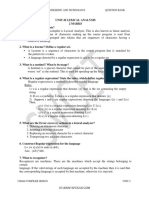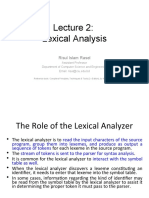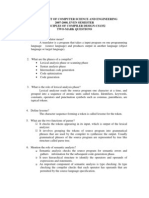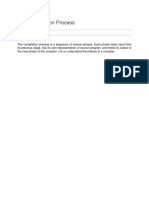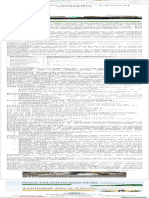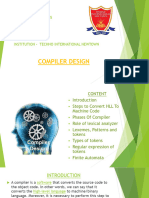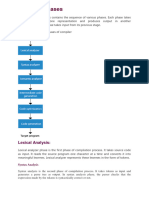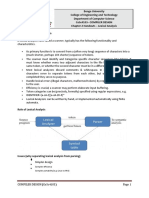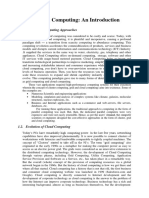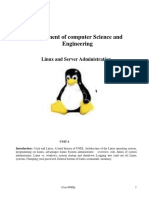100%(1)100% found this document useful (1 vote)
230 views2 Lexical
2 Lexical
Uploaded by
yas123The first phase of a compiler is the lexical analyzer, which recognizes basic language units called tokens. It classifies tokens into types like identifiers and keywords. Finite automata are used to precisely define the character sequences that belong to each token type. Regular expressions provide a textual representation of token definitions that can be used as input to a lexical analyzer generator tool, which produces a deterministic finite automaton table to recognize tokens.
Copyright:
Attribution Non-Commercial (BY-NC)
Available Formats
Download as PDF, TXT or read online from Scribd
2 Lexical
2 Lexical
Uploaded by
yas123100%(1)100% found this document useful (1 vote)
230 views7 pagesThe first phase of a compiler is the lexical analyzer, which recognizes basic language units called tokens. It classifies tokens into types like identifiers and keywords. Finite automata are used to precisely define the character sequences that belong to each token type. Regular expressions provide a textual representation of token definitions that can be used as input to a lexical analyzer generator tool, which produces a deterministic finite automaton table to recognize tokens.
Original Title
2Lexical
Copyright
© Attribution Non-Commercial (BY-NC)
Available Formats
PDF, TXT or read online from Scribd
Share this document
Did you find this document useful?
Is this content inappropriate?
The first phase of a compiler is the lexical analyzer, which recognizes basic language units called tokens. It classifies tokens into types like identifiers and keywords. Finite automata are used to precisely define the character sequences that belong to each token type. Regular expressions provide a textual representation of token definitions that can be used as input to a lexical analyzer generator tool, which produces a deterministic finite automaton table to recognize tokens.
Copyright:
Attribution Non-Commercial (BY-NC)
Available Formats
Download as PDF, TXT or read online from Scribd
Download as pdf or txt
100%(1)100% found this document useful (1 vote)
230 views7 pages2 Lexical
2 Lexical
Uploaded by
yas123The first phase of a compiler is the lexical analyzer, which recognizes basic language units called tokens. It classifies tokens into types like identifiers and keywords. Finite automata are used to precisely define the character sequences that belong to each token type. Regular expressions provide a textual representation of token definitions that can be used as input to a lexical analyzer generator tool, which produces a deterministic finite automaton table to recognize tokens.
Copyright:
Attribution Non-Commercial (BY-NC)
Available Formats
Download as PDF, TXT or read online from Scribd
Download as pdf or txt
You are on page 1of 7
Lexical Analysis
The first phase of the compiler is the lexical analyzer,
also known as the scanner, which recognizes the basic
language units, called tokens.
• The exact characters in a token is called its lexeme.
• Tokens are classified by token types, e.g. identi-
1
fiers, constant literals, strings, operators, punctua-
tion marks, and key words.
• Different types of tokens may have their own seman-
tic attributes (or values) which must be extracted
and stored in the symbol table.
• The lexical analyzer may perform semantic actions
to extract such values and insert them in the symbol
table.
• How to classify token types? It mainly depends on
what form of input is needed by the next compiler
phase, the parser. (The parser takes a sequence of
tokens as its input.)
2
After we decide how to classify token types, we can use
one of several ways to precisely express the classifica-
tion.
• A common method is to use a finite automaton to
define all character sequences (i.e. strings) which
belong to a particular token type.
3
• We shall look at several examples (e.g. in Figure
2.3) of token types and their corresponding finite
automata.
• The states, the starting state, the accepting states
of a finite automaton. An accepting state is also
called a final state.
Given the definitions of different token types, it is possi-
ble for a string to belong to more than one type. Such
ambiguity is resolved by assigning priorities to token
types. For example: Key words have a higher priority
over identifiers.
4
• Finite automata for different token types are com-
bined into a transition diagram for the lexical ana-
lyzer.
• Following the “longest match” rule – keep scanning
the next character until there is no corresponding
transition. The longest string which matches an ac-
ceptance state during the scanning is the recognized
5
token.
• Go back to the starting state of the transition dia-
gram, ready to recognize the next token in the pro-
gram.
• Semantic actions can be specified in the transition
diagram.
• (The lexical analyzer can also be used to remove
comments from the program.)
Merging several transition diagrams into one may create
the problem of nondeterminism.
6
A nondeterministic finite automaton (NFA) accepts an
input string x if and only if there exists some path from
the start state to some accepting state, such that the
edge labels along the path spell out x.
Let us look at examples of NFAs accepting and rejecting
strings. Pay attention to the treatment of ² in spelling
x: ²y = y and y² = y.
Scanners based on NFAs can be inefficient due to the
possibility of backtracking.
7
We study an algorithm which transform an NFA into a
DFA (deterministic finite automaton). This algorithm
can be found on P. 27.
The intuition behind the algorithm which transforms
an NFA to a DFA is factoring. Let us look at an ex-
tremely simple example first, to see the idea of factor-
ing.
The idea is formalized by identifying a set of states
which can be reached after scanning a substring.
8
For an NFA which contains ² edges, we also need to
define the ²-closure of a state s, which the set of states
reachable from s by taking ² transitions. The ²-closure
of s of course includes s itself.
Regular Expressions
A DFA can be easily implemented based on a table
look-up.
For a programming language which has a big alphabet
and many token types, it would be desirable to auto-
matically construct such a table.
9
Such a lexical-analyzer generator takes a definition
of token types as input and generate the DFA table.
The graphical form of DFA is not suitable as an input
to the lexical-analyzer generator. Some textual repre-
sentation is needed.
Regular expressions are such a textual representation.
Regular expressions are equivalent to DFAs in that:
1) For any given regular expression, there exist a DFA
which accepts the same set of strings represented by
10
the regular expression.
2) For a given DFA, there exist a regular expression
which represents the same set of strings accepted by
the DFA.
Regular expressions are composed by following a set
of syntax rules:
• Given an input alphabet Σ, a regular expression is a
string of symbols from the union of the set Σ and
the set { (, ), ∗, |, ² }
• The regular expression ² defines a language which
11
contains the null string. What is the DFA to recog-
nize it?
• The regular expression a defines the language { a }.
• If regular expressions RA and RB define languages
A and B, respectively, then the regular expression
(RA) | (RB ) defines the language A ∪ B, the reg-
ular expression (RA)(RB ) defines the language AB
(concatenation), and the regular expression (RA)∗
defines the language A∗ (Kleene closure).
• The parentheses define the order of the construc-
tion operators (|, ∗ and concatenation) in regular
expressions. Within the same pair of parentheses (or
among the operators not in any parentheses), ∗ takes
12
the highest precedence, concatenation comes next, |
comes last.
• When a pair of parentheses are unnecessary for defin-
ing precedences, they can be omitted.
Let us look at a number of examples of regular expres-
sions, including those in Figure 2.2.
Two regular expressions are equivalent if they represent
the exactly the same set of strings.
There exist algorithms which, for any regular expression
13
E, can directly construct a DFA to recognize the set of
strings represented by E. We shall not study such a
direct algorithm. Instead, we study an algorithm which
construct an NFA for the given regular expression (see
P. 25).
We already know how to convert NFA to DFA.
There also exist algorithms which, for any DFA M ,
can construct a regular expression which represents
the set of strings recognized by M . (Unfortunately,
sometimes the regular expression generated by such
algorithms can be difficult to read.) We do not discuss
14
such algorithms in this course.
The compiler-generator tool JavaCC contains a lexical-
analyzer generator. In our project, we will apply the
tool to a simple language called miniJava. This will be
discussed in our PSOs.
You might also like
- Spamming Tutorial: What What What What Is IS IS Is Spamming Spamming Spamming SpammingDocument20 pagesSpamming Tutorial: What What What What Is IS IS Is Spamming Spamming Spamming Spammingfaithscott75% (4)
- CS3304 9 LanguageSyntax 2 PDFDocument39 pagesCS3304 9 LanguageSyntax 2 PDFrubaNo ratings yet
- Kali Linux Tools DescriptionsDocument26 pagesKali Linux Tools DescriptionsTajria Sultana100% (2)
- Ch13 ADC, DAC and Sensor InterfacingDocument33 pagesCh13 ADC, DAC and Sensor InterfacingSimple knowledgeNo ratings yet
- Sri Vidya College of Engineering and Technology Question BankDocument5 pagesSri Vidya College of Engineering and Technology Question BankThiyagarajan JayasankarNo ratings yet
- Lexical Analysis: Risul Islam RaselDocument148 pagesLexical Analysis: Risul Islam RaselRisul Islam RaselNo ratings yet
- 2 LexicalAnalysisDocument11 pages2 LexicalAnalysisAdrija DeNo ratings yet
- Compiler Construction Lecture NotesDocument27 pagesCompiler Construction Lecture NotesFidelis GodwinNo ratings yet
- Chapter Two (3) (Autosaved)Document29 pagesChapter Two (3) (Autosaved)firomsadine59No ratings yet
- Compiler Construction Lecture Notes: Why Study Compilers?Document16 pagesCompiler Construction Lecture Notes: Why Study Compilers?jaseregNo ratings yet
- Final Report Daar 01 Carlo SegatttttttttttttttttttDocument8 pagesFinal Report Daar 01 Carlo SegatttttttttttttttttttlatebmelissaNo ratings yet
- 2.1 Constituents of Lexical AnalysisDocument10 pages2.1 Constituents of Lexical AnalysisiucguiwetfcukwVNo ratings yet
- 1586345305compiler Construction Lecture 1Document4 pages1586345305compiler Construction Lecture 1rosemaryjibrilNo ratings yet
- Cs1352 Principles of Compiler DesignDocument33 pagesCs1352 Principles of Compiler DesignSathishDon01No ratings yet
- Chapter 2-Lexical AnalysisDocument31 pagesChapter 2-Lexical Analysismishamoamanuel574No ratings yet
- CSC 318 Class NotesDocument21 pagesCSC 318 Class NotesYerumoh DanielNo ratings yet
- Compiler Construction NotesDocument21 pagesCompiler Construction NotesvinayNo ratings yet
- Compiler Design - Lexical Analysis: University of Salford, UKDocument1 pageCompiler Design - Lexical Analysis: University of Salford, UKAmmar MehmoodNo ratings yet
- Day 4 - Finite AutomataDocument52 pagesDay 4 - Finite AutomataYeabsiraNo ratings yet
- Lesson 16Document36 pagesLesson 16sdfgedr4tNo ratings yet
- Unit II - Lexical Analysis-20-1-2021Document49 pagesUnit II - Lexical Analysis-20-1-2021Yattin GaurNo ratings yet
- Compiler Design - Lexical AnalysisDocument16 pagesCompiler Design - Lexical AnalysisbourefrefabdennourNo ratings yet
- Ayan Saha - 10700121101Document10 pagesAyan Saha - 10700121101Ayan SahaNo ratings yet
- Lexical Analyzer (Compiler Contruction)Document6 pagesLexical Analyzer (Compiler Contruction)touseefaq100% (1)
- Day 5 - Syntax AnalysisDocument46 pagesDay 5 - Syntax AnalysisYeabsiraNo ratings yet
- VMKV Engineering College Department of Computer Science & Engineering Principles of Compiler Design Unit I Part-ADocument80 pagesVMKV Engineering College Department of Computer Science & Engineering Principles of Compiler Design Unit I Part-ADular ChandranNo ratings yet
- GrammarDocument10 pagesGrammarseddorNo ratings yet
- Lexical AnalysisDocument45 pagesLexical AnalysisneetquizforuNo ratings yet
- Compiler 18700220055 PrathamraiDocument12 pagesCompiler 18700220055 PrathamraiPratham RaiNo ratings yet
- Lesson 13Document35 pagesLesson 13sdfgedr4tNo ratings yet
- Compiler Design Imortant QuestionsDocument28 pagesCompiler Design Imortant QuestionsKunal JaiswalNo ratings yet
- CS-352 - Spring 2024 - Lec3Document35 pagesCS-352 - Spring 2024 - Lec3jouf00008No ratings yet
- 003chapter 3 - Syntax AnalysisDocument171 pages003chapter 3 - Syntax AnalysisEyoabNo ratings yet
- Compiler 2Document10 pagesCompiler 2Jabin Akter JotyNo ratings yet
- Chapter 2 Lexical AnalysisDocument55 pagesChapter 2 Lexical Analysisabrahamayele267No ratings yet
- Lesson 11Document38 pagesLesson 11sdfgedr4tNo ratings yet
- CD Unit-2Document64 pagesCD Unit-2dartionjpNo ratings yet
- ExpressionDocument9 pagesExpressionSBRKA0% (1)
- Lecture 2Document20 pagesLecture 2as.business.023No ratings yet
- Chapter 3 Finite Automata and Lexical AnalysisDocument95 pagesChapter 3 Finite Automata and Lexical AnalysisYohannes DerejeNo ratings yet
- SE Compiler Chapter 2Document16 pagesSE Compiler Chapter 2mikiberhanu41No ratings yet
- CC QuestionsDocument9 pagesCC QuestionsjagdishNo ratings yet
- Computer ScienceDocument111 pagesComputer Sciencehuxton.zyheirNo ratings yet
- Lexical AnalysisDocument88 pagesLexical AnalysisSannidhanapu harikaNo ratings yet
- Compiler Design 1Document30 pagesCompiler Design 1Laptop StorageNo ratings yet
- Lexical Analysis: Deterministic Finite AutomataDocument37 pagesLexical Analysis: Deterministic Finite Automatavorava2846No ratings yet
- ch3 M.PPTX - 0Document46 pagesch3 M.PPTX - 0natnaelpom0No ratings yet
- Chapter 2 - Lexical Analysis_Regular Expressions(1)Document27 pagesChapter 2 - Lexical Analysis_Regular Expressions(1)bbtmk.fmNo ratings yet
- Acd Unit-2Document16 pagesAcd Unit-2sujanabellapukondaNo ratings yet
- Lexical AnalyzerDocument18 pagesLexical Analyzerbhawana.tyagiNo ratings yet
- Compiler RewindDocument52 pagesCompiler RewindneelamysrNo ratings yet
- Automata and Complexity TheoryDocument18 pagesAutomata and Complexity Theoryfadil Yusuf100% (3)
- CC Note 1Document11 pagesCC Note 1its.vikas013No ratings yet
- Chapter Two LexicalAnalysisDocument16 pagesChapter Two LexicalAnalysisAsfaw BassaNo ratings yet
- Here are the answers to the questions in the provided Compiler Design final assignmentDocument20 pagesHere are the answers to the questions in the provided Compiler Design final assignmentLeon jrNo ratings yet
- Lexical Analysis Using Jflex: TokensDocument39 pagesLexical Analysis Using Jflex: TokensCarlos MaldonadoNo ratings yet
- Lec 5Document20 pagesLec 5Mohammad HumayunNo ratings yet
- toc mod3Document72 pagestoc mod3eng23am3003No ratings yet
- Compiler ConstructionDocument35 pagesCompiler ConstructionZargham DurraniNo ratings yet
- New Questions Add DumpDocument9 pagesNew Questions Add DumpkariimNo ratings yet
- Ib 1501272 EngpDocument894 pagesIb 1501272 EngpRuslanNo ratings yet
- Data Acquisition System: Sumeet Patel Enroll. No. - 110050111040Document25 pagesData Acquisition System: Sumeet Patel Enroll. No. - 110050111040Princy Merin JoseNo ratings yet
- Mainframe Online Training Content VenkatDocument6 pagesMainframe Online Training Content Venkatuday 215No ratings yet
- Mark Scheme Fundamentals of ItDocument15 pagesMark Scheme Fundamentals of ItDavid GeeNo ratings yet
- Java Question Bank AnsDocument33 pagesJava Question Bank AnsNi anna maddaNo ratings yet
- 869df5e47080aefbed69911b1e47cf27Document500 pages869df5e47080aefbed69911b1e47cf27sandeepNo ratings yet
- ScriptDocument10 pagesScriptarkadeeproy425No ratings yet
- BODS Interview QstnsDocument5 pagesBODS Interview QstnsKoppolu SatyaNo ratings yet
- Unit 1: Cloud Computing: An IntroductionDocument123 pagesUnit 1: Cloud Computing: An IntroductionBaibhav SagarNo ratings yet
- Iteration: Chapter GoalsDocument46 pagesIteration: Chapter GoalsAni AniNo ratings yet
- Ofi Unit4 2Document28 pagesOfi Unit4 2Deepak DhaimodeNo ratings yet
- Courses For Itsi AdminsDocument1 pageCourses For Itsi AdminsRodel G. SanchezNo ratings yet
- r16 Syllabus Cse JntuhDocument58 pagesr16 Syllabus Cse Jntuhramakanth83No ratings yet
- APznzab 23fWwcCW4RaZuGeff qeVtmX GflGQWZmPW0PfHQ8oVAnfuzBfxT5sxbY PznZ8vTipf2YwrNPJiFEEbt - GSQ5wG07IQ - XDocument62 pagesAPznzab 23fWwcCW4RaZuGeff qeVtmX GflGQWZmPW0PfHQ8oVAnfuzBfxT5sxbY PznZ8vTipf2YwrNPJiFEEbt - GSQ5wG07IQ - XVersha KumariNo ratings yet
- Gopala Krishna Reddy - Devops EngineerDocument2 pagesGopala Krishna Reddy - Devops Engineerkal kastNo ratings yet
- The Bild Men and The Elephant'Document94 pagesThe Bild Men and The Elephant'BalingkangNo ratings yet
- Theory of AutomataDocument34 pagesTheory of AutomataFatimaNo ratings yet
- R18B Tech EEESyllabusDocument3 pagesR18B Tech EEESyllabussaiNo ratings yet
- LinusDocument15 pagesLinusAbel HaileNo ratings yet
- Scalance - x1011 Commisioning ManualDocument86 pagesScalance - x1011 Commisioning Manualdbhzj76hz9No ratings yet
- BODAS-service: RE 95086/2021-04-19 Replaces: 2020-03-02Document10 pagesBODAS-service: RE 95086/2021-04-19 Replaces: 2020-03-02Vinod HegdeNo ratings yet
- Geh-6760 eDocument102 pagesGeh-6760 ebmw316No ratings yet
- Software Development Engineer: SkillsDocument2 pagesSoftware Development Engineer: SkillsIlya ProidakovNo ratings yet
- Research Day FOR MLBBDocument7 pagesResearch Day FOR MLBBMichael Vernice NievaNo ratings yet
- Introduction To Pseudocode Algorithm HandoutDocument4 pagesIntroduction To Pseudocode Algorithm HandoutAkua LattyNo ratings yet
- Itts Final Requirement Vince UgaldeDocument60 pagesItts Final Requirement Vince UgaldeLesterr De leonNo ratings yet





